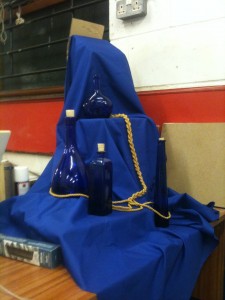|
 Day 1 of a still life begins for me with an idea of what to paint. In this case, I had had the idea of a long fall of blue glass for some time. In fact, I have already completed a colour test which was interesting but fell short of the scale on which I wanted to paint. That makes the setting up of this still life day 3 of the process. The first thing to do was set up the platforms. I wanted one long fall, an arch of material that went outwards, and stopping points for all of the lines. I wanted highlights or corks or areas of dark shadow in the hotspots of the paintings. I wanted the gold cord to fall perfectly. Day 1 of a still life begins for me with an idea of what to paint. In this case, I had had the idea of a long fall of blue glass for some time. In fact, I have already completed a colour test which was interesting but fell short of the scale on which I wanted to paint. That makes the setting up of this still life day 3 of the process. The first thing to do was set up the platforms. I wanted one long fall, an arch of material that went outwards, and stopping points for all of the lines. I wanted highlights or corks or areas of dark shadow in the hotspots of the paintings. I wanted the gold cord to fall perfectly.
I traded off things I wanted until I could have something I could paint. I will work very carefully with the tones on the bottles to make sure I have the right depth to the glass, and I have always found that for me the drapery falls into place, no pun intended. I am going to have to simplify the folds, because thin cloth looks cheap. I cannot afford velvet in royal blue, and so I have this fake silk instead. I spent about an hour trying out different decorative knots on the cord. If you want the world champion Bad Monkey’s Fist knotter, here I am. Give me a medal without a ribbon, please.
The plait falls into several parts, so that the cord is part of the painting, and not just a decoration. It has a straight near-vertical part and then a complicated area at the bottom, where I want more attention to be. It touches every bottle and goes from level to level, keeping the pieces together with more than just the different shades of cloth between them. Even if I had another yard of it, I am not sure I would make the braid longer. The thin/thick organised/chaotic look goes well.
I have gone with a thing that makes me comfortable, having the weight of the painting down in the bottom left. I paint a lot that way, and it is a habit that has not yet become predictable. In the top right, there will be a dark near-blank area to balance the busy canvas elsewhere. The arrangement will stand near to the foreground, so that I can light it up against the darkness behind. Winter is a challenge for darkness. I have to have my lights on in the studio from early afternoon, and I cannot block off a skylight that will cast a very tricky shape of light. The tall, thin light on the biggest of the bottles is the reflection of the sky, through my skylight. It is what makes the light in my studio fantastic, but it is also horrible for painting glass. I am going to have to paint it out, ignore it, shade it, or mute it somehow.
 That was a day of walking back and forth, looking at things from different angles, stopping for tea, cursing my broken camera phone, and sitting at the front of the gallery, learning I was not cut out for decorative knotwork. I also did some admin, and then I laid out the skeleton of the painting, so I could see the layout. I started with blobbing paint on the spots where I wanted there to be visual interest. In the painting here you can see the blobs on top and the original path of the braid, before I undid it for the last time, and put it in its current position. That was a day of walking back and forth, looking at things from different angles, stopping for tea, cursing my broken camera phone, and sitting at the front of the gallery, learning I was not cut out for decorative knotwork. I also did some admin, and then I laid out the skeleton of the painting, so I could see the layout. I started with blobbing paint on the spots where I wanted there to be visual interest. In the painting here you can see the blobs on top and the original path of the braid, before I undid it for the last time, and put it in its current position.
The clear ‘I did this and then I did that’ which these posts follow is generally a slight simplification. In this case, there was a lot of to and fro’ from physical model to canvas design and back. I moved the bottle on the right backwards and towards the right edge of the canvas, and then had to replait the cord to make it all fit together. I turned the square bottle but kept the shouldered one fully facing the seat where I paint. I tugged cloth until the lines were attractive and the triangles were clear. Then I left it, once I had the basic design down on the canvas, to percolate for the next few days.
|